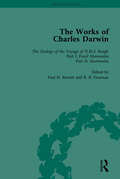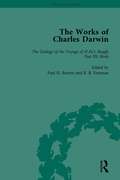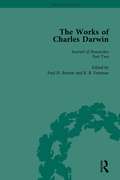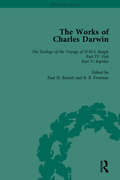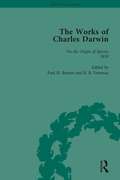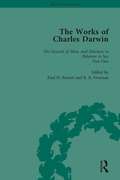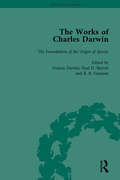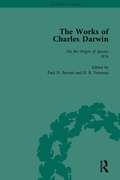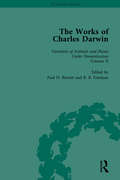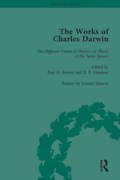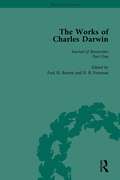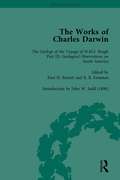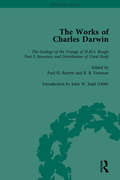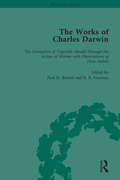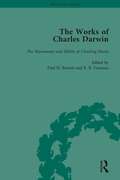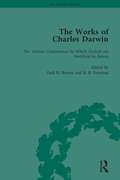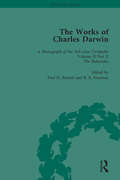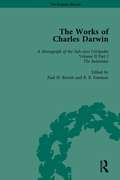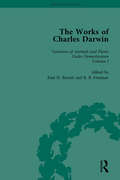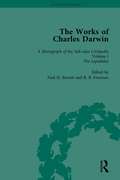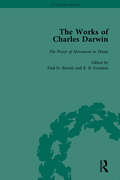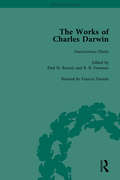- Table View
- List View
The Works of Charles Darwin: Electronic Edition (The Pickering Masters #17)
by Paul H BarrettThe fourth volume in a 29-volume set which contain all Charles Darwin's published works. Darwin was one of the most influential figures of the 19th century. His work remains a central subject of study in the history of ideas, the history of science, zoology, botany, geology and evolution.
The Works of Charles Darwin: Erasmus Darwin By Ernest Krause, With A Preliminary Notice By Charles Darwin; The Autobiography Of Charles Darwin Edited By Nora Barlow; And Consolidated Index (The Pickering Masters #16)
by Paul H BarrettThe 29th volume in a 29-volume set which contain all Charles Darwin's published works. This volume concludes with a text on Erasmus Darwin, grandfather of Charles Darwin and the autobiography of Charles Darwin.
The Works of Charles Darwin: Erasmus Darwin By Ernest Krause, With A Preliminary Notice By Charles Darwin; The Autobiography Of Charles Darwin Edited By Nora Barlow; And Consolidated Index (The Pickering Masters #16)
by Paul H BarrettThe fourteenth volume in a 29-volume set which contain all Charles Darwin's published works. Darwin was one of the most influential figures of the 19th century. His work remains a central subject of study in the history of ideas, the history of science, zoology, botany, geology and evolution.
The Works of Charles Darwin: The Power Of Movement In Plants (The Pickering Masters #17)
by Paul H BarrettThe fifth volume in a 29-volume set which contain all Charles Darwin's published works. Darwin was one of the most influential figures of the 19th century. His work remains a central subject of study in the history of ideas, the history of science, zoology, botany, geology and evolution.
The Works of Charles Darwin: The Power Of Movement In Plants (The Pickering Masters #17)
by Paul H BarrettThe third volume in a 29-volume set which contain all Charles Darwin's published works. Darwin was one of the most influential figures of the 19th century. His work remains a central subject of study in the history of ideas, the history of science, zoology, botany, geology and evolution.
The Works of Charles Darwin: The Power Of Movement In Plants (The Pickering Masters #17)
by Paul H BarrettThe sixth volume in a 29-volume set which contain all Charles Darwin's published works. Darwin was one of the most influential figures of the 19th century. His work remains a central subject of study in the history of ideas, the history of science, zoology, botany, geology and evolution.
The Works of Charles Darwin: The Power Of Movement In Plants (The Pickering Masters #17)
by Paul H BarrettThe fifteenth volume in a 29-volume set which contain all Charles Darwin's published works. Darwin was one of the most influential figures of the 19th century. His work remains a central subject of study in the history of ideas, the history of science, zoology, botany, geology and evolution.
The Works of Charles Darwin: The Power Of Movement In Plants (The Pickering Masters #17)
by Paul H BarrettThe 21st volume in a 29-volume set which contain all Charles Darwin's published works. Darwin was one of the most influential figures of the 19th century. His work remains a central subject of study in the history of ideas, the history of science, zoology, botany, geology and evolution.
The Works of Charles Darwin: The Power Of Movement In Plants (The Pickering Masters #17)
by Paul H BarrettThe tenth volume in a 29-volume set which contain all Charles Darwin's published works. Darwin was one of the most influential figures of the 19th century. His work remains a central subject of study in the history of ideas, the history of science, zoology, botany, geology and evolution.
The Works of Charles Darwin: The Power Of Movement In Plants (The Pickering Masters #17)
by Paul H BarrettThe sixteenth volume in a 29-volume set which contain all Charles Darwin's published works. Darwin was one of the most influential figures of the 19th century. His work remains a central subject of study in the history of ideas, the history of science, zoology, botany, geology and evolution.
The Works of Charles Darwin: The Power Of Movement In Plants (The Pickering Masters #17)
by Paul H BarrettThe twentieth volume in a 29-volume set which contain all Charles Darwin's published works. Darwin was one of the most influential figures of the 19th century. His work remains a central subject of study in the history of ideas, the history of science, zoology, botany, geology and evolution.
The Works of Charles Darwin: The Power Of Movement In Plants (The Pickering Masters #17)
by Paul H BarrettThe 26th volume in a 29-volume set which contain all Charles Darwin's published works. Darwin was one of the most influential figures of the 19th century. His work remains a central subject of study in the history of ideas, the history of science, zoology, botany, geology and evolution.
The Works of Charles Darwin: The Power Of Movement In Plants (The Pickering Masters #17)
by Paul H BarrettThe second volume in a 29-volume set which contain all Charles Darwin's published works. Darwin was one of the most influential figures of the 19th century. His work remains a central subject of study in the history of ideas, the history of science, zoology, botany, geology and evolution.
The Works of Charles Darwin: The Power Of Movement In Plants (The Pickering Masters #17)
by Paul H BarrettThe ninth volume in a 29-volume set which contain all Charles Darwin's published works. Darwin was one of the most influential figures of the 19th century. His work remains a central subject of study in the history of ideas, the history of science, zoology, botany, geology and evolution.
The Works of Charles Darwin: The Power Of Movement In Plants (The Pickering Masters #17)
by Paul H BarrettThe seventh volume in a 29-volume set which contain all Charles Darwin's published works. Darwin was one of the most influential figures of the 19th century. His work remains a central subject of study in the history of ideas, the history of science, zoology, botany, geology and evolution.
The Works of Charles Darwin: The Power Of Movement In Plants (The Pickering Masters #17)
by Paul H BarrettThe 28th volume in a 29-volume set which contain all Charles Darwin's published works. Darwin was one of the most influential figures of the 19th century. His work remains a central subject of study in the history of ideas, the history of science, zoology, botany, geology and evolution.
The Works of Charles Darwin: The Power Of Movement In Plants (The Pickering Masters #17)
by Paul H BarrettThe eighteenth volume in a 29-volume set which contain all Charles Darwin's published works. Darwin was one of the most influential figures of the 19th century. His work remains a central subject of study in the history of ideas, the history of science, zoology, botany, geology and evolution.
The Works of Charles Darwin: The Power Of Movement In Plants (The Pickering Masters #17)
by Paul H BarrettThe seventeenth volume in a 29-volume set which contain all Charles Darwin's published works. Darwin was one of the most influential figures of the 19th century. His work remains a central subject of study in the history of ideas, the history of science, zoology, botany, geology and evolution.
The Works of Charles Darwin: The Power Of Movement In Plants (The Pickering Masters #17)
by Paul H BarrettThe thirteenth volume in a 29-volume set which contain all Charles Darwin's published works. Darwin was one of the most influential figures of the 19th century. His work remains a central subject of study in the history of ideas, the history of science, zoology, botany, geology and evolution.
The Works of Charles Darwin: The Power Of Movement In Plants (The Pickering Masters #17)
by Paul H BarrettThe eighth volume in a 29-volume set which contain all Charles Darwin's published works. Darwin was one of the most influential figures of the 19th century. His work remains a central subject of study in the history of ideas, the history of science, zoology, botany, geology and evolution.
The Works of Charles Darwin: The Power Of Movement In Plants (The Pickering Masters #17)
by Paul H BarrettThe twelfth volume in a 29-volume set which contain all Charles Darwin's published works. Darwin was one of the most influential figures of the 19th century. His work remains a central subject of study in the history of ideas, the history of science, zoology, botany, geology and evolution.
The Works of Charles Darwin: The Power Of Movement In Plants (The Pickering Masters #17)
by Paul H BarrettThe nineteenth volume in a 29-volume set which contain all Charles Darwin's published works. Darwin was one of the most influential figures of the 19th century. His work remains a central subject of study in the history of ideas, the history of science, zoology, botany, geology and evolution.
The Works of Charles Darwin: The Power Of Movement In Plants (The Pickering Masters #17)
by Paul H BarrettThe eleventh in a 29-volume set which contain all Charles Darwin's published works. Darwin was one of the most influential figures of the 19th century. His work remains a central subject of study in the history of ideas, the history of science, zoology, botany, geology and evolution.
The Works of Charles Darwin: The Power Of Movement In Plants (The Pickering Masters #17)
by Paul H BarrettThe 27th volume in a 29-volume set which contain all Charles Darwin's published works. Darwin was one of the most influential figures of the 19th century. His work remains a central subject of study in the history of ideas, the history of science, zoology, botany, geology and evolution.
The Works of Charles Darwin: The Power Of Movement In Plants (The Pickering Masters #17)
by Paul H BarrettThe 24th volume in a 29-volume set which contain all Charles Darwin's published works. Darwin was one of the most influential figures of the 19th century. His work remains a central subject of study in the history of ideas, the history of science, zoology, botany, geology and evolution.
